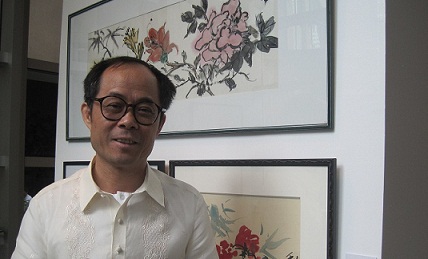Text and photos by ELIZABETH LOLARGA
LIPING Zheng is like a mandarin transported from ancient China. His passion for traditional painting and calligraphy matches his commitment to his work as lead urban development specialist and advisor for South Asia at the Asian Development Bank.
He finds no contradictions in these pursuits. He’s just following a tradition in his home country. In the time of the dynasties, the norm was those who wanted to join the hierarchy and become public officials had to be educated and pass rigorous exams. They must be able to wield the brush, compose poems and paint images.
So a bureaucrat in those times was also a member of the literati. Zheng said, “If you could handle the brush properly, you were a person of good caliber. It wasn’t enough that you had skills. You had to know poems, you had to be good in the mind.”
He’s steeped in history and culture and considers himself “living in ancient time or beyond this time.” His modern side is his training as a mechanical engineer, his master in public administration from Harvard University and PhD in economics from Nankai University in Tianjin. These qualified him earlier for the positions of mayor and chairman of Yunfu, Guangdong, a city with three million people. “Almost like Cebu,” he said.
He spent his childhood in Jieyang, reputed to be “the town of Chinese painting.” During the Ming and Ching dynasties, many painters traced their roots there. In the late 1920s and early ’30s, Jieyang artists went to Shanghai for their education, but returned to Guangdong before the war broke out. The province was far from the battle fields.
These artists went unappreciated when the communists took over in 1949. The new art espoused was heavy on propaganda. Tradition was cast aside. Art education became a hybrid that adopted Western painting techniques.
The older painters became elementary and high school teachers, but they didn’t abandon their art. On Sundays they got together in someone’s backyard and painted. Zheng, then in middle school, joined them, copied their works and presented them for approval. Students in Chinese painting begin with copying before becoming more accomplished.
He found painting a good way of “expressing myself, my feelings, my sense of beauty, what I like and love.” He added that his style belongs to the school of “big sense writing” that allows more freedom in executing landscapes, birds and flowers.
Portraiture isn’t his forte because it requires faithfulness to a subject that he finds limiting. Zheng doesn’t want to sacrifice the freedom in, for example, painting a peony with the vitality he is known for in the China Artists Association. He said, “It’s my country’s national flower, but I don’t focus on that. I prefer to show how rich and glorious the peony looks.”
Nature is a bottomless inspiration. He doesn’t need to venture outdoors to look for subjects. He explained, “What an object actually looks like is not important to me. What’s important is my feeling, the sense of upliftment.”
Art critics have noted Zheng’s optimism reflected in his works on Xuan paper or silk. For 20 years, he has been using his supply of paper from Anhui province.
He said, “It’s absolutely handmade. No machine can make paper that big.” The pigments he uses are also handmade, not store-bought paint cakes or tubes. He uses a ceramic stick to mix them in a bowl with transparent glue.
He described the process: “I grind an ink stick on an ink maker made from a special stone. The stick is made from smoke collected from burning either a pine tree branch or tung oil, a kind of wood oil. The color is from mineral materials or plants, either in solid or powder form. I grind them in a bowl. The brushes I have been using are soft and long ones made from goat wool.” All are from China.
When he has “a smooth beginning,” he can finish a work in two hours. If the beginning isn’t smooth, it takes him from two to three days. He began one huge work (five meters high, 1.9 meters wide), “Lucky Breeze,” at 3 p.m. and finished it at 1 a.m., stopping only for dinner. It’s now at the lobby of the five-star Baohui Hotel in Shenzhen,
If he isn’t satisfied with a painting, he adjusts again and again. This is part of the process–to never give up. In a year, he tears up just one unsatisfactory work, but that rarely happens.
(Zheng’s “A Passionate World” is up at ArtistSpace until Aug. 5. The gallery is behind Ayala Museum on De la Rosa Street and Makati Ave., Makati City. It is open Monday–Friday, 10 a.m.–6 p.m., Saturday and Sunday, 10 a.m.–7 p.m.)
